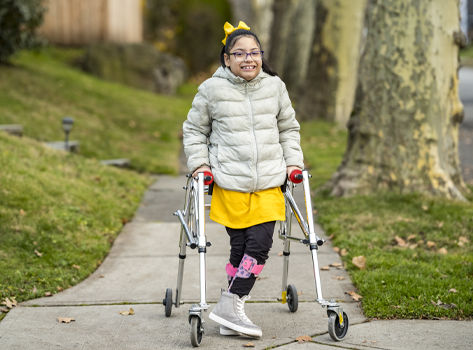
Seven-year-old Samantha E. was born early, at just 27 weeks. Her barely two-pound body entered the world needing lots of rest and critical life support — and true to form, the neonatal intensive care unit (NICU) nurtured her growth and development so that Samantha could go home with mom and dad.
But, before she was discharged, doctors evaluated her cognitive, behavioral and functional abilities. That was when the first-time parents, Yiselle and David, realized their baby daughter had a brain injury. Known as periventricular leukomalacia (PVL), the in-utero brain damage that affects premature infants, left baby Samantha with cerebral palsy.
“The neurologist gave us the official diagnosis in the NICU and we were devastated,” says Yiselle. “Samantha was born with a brain bleed that had caused cerebral palsy and we had no idea how her condition would progress. We arranged for early interventions with a physical therapist who suggested we talk with Hannah Shoval, MD, a physiatrist. It was a referral for which I will be forever grateful.”
Samantha Continues Her Health Care Journey
“Periventricular leukomalacia is damage to the brain’s white matter that affects movement,” says Dr. Shoval, chief of pediatric physical medicine and rehabilitation at Atlantic Health System. “A common symptom of PVL is spasticity — tight muscles that resist movement. Without treatment, it can limit a child’s ability to hold objects, sit or walk. It can also cause permanent joint contracture, hip dislocation and pain.”
Samantha’s treatments consisted of physical and occupational therapy, leg braces for stretching and stability, and serial casting for progressive stretching. But she still couldn’t stand up straight because her muscles were so tight.
“We used regular alcohol nerve blocks and Botox injections so Samantha could stand straighter, move her legs more, build strength, and prevent permanent bone damage,” says Dr. Shoval. As she grew older, she became a candidate for a more permanent treatment for her spasticity.”
Morristown Medical Center’s Spasticity and Gait Clinic
Dr. Shoval recommended a neurosurgery called selective dorsal rhizotomy (SDR), a minimally invasive spine procedure for children with cerebral palsy. Selective dorsal rhizotomy is highly successful in permanently reducing leg spasticity to enable walking, improve pain, and ease the care that children with cerebral palsy may require.
As the director of the Morristown Medical Center Spasticity and Gait Clinic, Dr. Shoval arranged for Samantha to meet with her multispecialty team. It involved physical therapists and bracing specialists; neurologist Anjani Chitrapu, MD; chief of pediatric orthopedic surgery Ellen Dean Davis, MD; and chief of neurosurgery Richard Anderson, MD. Together, they determined that Dr. Anderson should perform the neurosurgery to loosen tension in Samantha’s leg muscles.
A Promising Neurosurgical Solution
Following the six-hour procedure, which involved cutting some of the nerve roots from Samantha’s spine that created the muscle tightness, Samantha immediately had an improved ability to stand and walk. She could also feel the sense of muscle ‘looseness’ in her legs.
“The surgery was very successful, and we were astonished to see that Samantha had better trunk control almost immediately,” says Yiselle, “Here before my eyes, my six-year-old daughter was standing totally upright for the first time in her life with her feet completely flat on the floor. She can now walk on her own with a walker, lay flat on her stomach, and sit criss-cross applesauce. The surgery was a game-changer. It has made her life easier and pain-free.”
Continued Progress with Therapy and Rehabilitation
Dr. Shoval has quarterbacked Samantha’s care from the time she was just over a year old so she knew this determined young lady would do well. Recovery, of course, would require ongoing work to strengthen muscles that Samantha had never used before. But Dr. Shoval has a plan for that, too. Samantha will soon begin working with senior physical therapist Diana Deshefy for a series of serial casting to improve her range of movement now that the spasticity and tightness are gone.
Yiselle adds, “We’re hopeful that Samantha will be walking on her own a year from now. I see her progress every day and she’s doing amazing things. Her physical and mental strength comes from a belief that she can do it, and she can. None of this would have been possible without Dr. Shoval and the incredible care team she put together for us.”
Be Proactive About Your Health
To stay safe and healthy, it's good to have a primary care provider who knows and understands your health history and wellness goals.